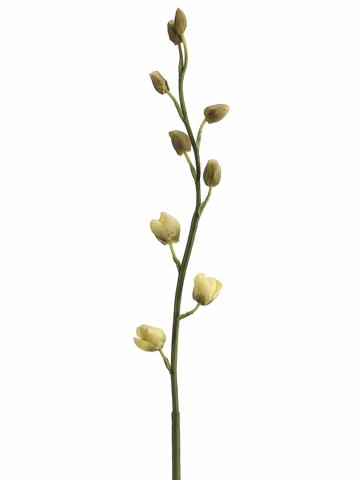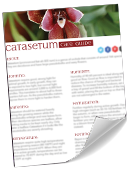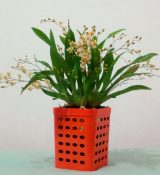Sound Like a Pro: The Ultimate Orchid Glossary
Author: Celeste Booth1 Comment
Care and Culture, Classification
When researching information on orchid care, varieties, and helpful tips there can be a lot of unfamiliar words that are specific to orchid-growing. To help you navigate and understand the information that might be relevant to you, we’ve compiled a list of frequently used vocabulary amongst orchid growers and enthusiasts.

Buds on an Orchid Plant
alba — A white orchid.
aerial root — Any root produced above the growing medium.
anther — The part of the stamen containing the pollen.
backbulb —An old, often leafless, pseudobulb that is still alive and can be used for propagating a new plant.
bifoliate — Having two leaves.
bud — Common term for a flower before it begins enlarging.
column — The fused sexual organ of an orchid flower, found atop the lip.
cross — The progeny that result from transferring pollen from one plant to the flower of another; the act itself.
crown — The central part of the rosette of leaves in a monopodial orchid such as Pbalaenopsis, from which new growth arises upward.
cultivar — An individual plant and its vegetative propagations in cultivation.
diploid — A plant with two sets of chromosomes.
division — Making new plants from old by cutting the rhizome of a sympodial orchid into pieces containing pseudobulbs and rhizome or by cutting off the top half of a stem of a vinelike orchid.
dormancy — A rest period during which no vegetative growth occurs, often following a growth period and/or the loss of leaves or other growths; may require cooler temperatures and less water.
dorsal sepal — In orchids, the uppermost “petal” of a flower.
epiphyte, epiphytic — A plant which naturally grows upon another plant but its nutrients are not taken from the supporting host but are derived instead from rain, air, and available debris.
footcandle — A measure of light useful in determining intensity of light for growing orchids; the illumination produced by a candle at a distance of one foot.
genus (pl. genera) — A natural grouping of closely related species.
growths — Any new shoots that emerge, whether they be pseudobulb, rhizome, leaf, stem, inflorescence, or root.
habitat — The place that the plant normally grows.
hybrid — The offspring of a cross between two different species or hybrids.
inflorescence — The flowering portion of a plant.
intergeneric hybrid — A hybrid between members of two or more genera.
keiki — A Hawaiian word referring to a baby plant produced asexually by an orchid plant.
lead — An immature vegetative growth that will develop into flower-producing structure.
lip — The orchid labellum: A modified petal of the orchid flower specialized to aid in pollination and different than the other petals.
lithophyte — An orchid that grows on rocks.
medium — The material in which an orchid is container-grown, it may be organic such as fir bark or inorganic such as lava rock.
mericlone — A plant derived from tissue culture that is identical to its parent.
meristem — The actively growing area of the plant from which mature tissues such as leaves, stems, flowers and roots originate.
micropropagation — Making new orchids by any of the laboratory techniques, including meristem tissue propagation and sterile seed culture.
monopodial — Orchids which grow upward from a single stem producing leaves and flowers along that stem.
natural hybrid — A hybrid that occurs in the wild without the help of humans.
node — A joint on a stem or pseudobulb from which a leaf or growth originates.
panicle — An inflorescence with a main stem and branches, the flowers on the lower branches open earlier than the upper ones.
photosynthesis — The process a plant uses to produce carbohydrates and sugar from water and carbon dioxide in the air using chlorophyl-containing cells exposed to light.
polyploid — A plant with more than the normal two sets of chromosomes.
propagation — The act of producing more plants from an original, either through seeds, offshoots, or division.
pseudobulb — A thickened portion of the stem of many orchids functioning as a water and food storage device.
raceme — An unbranched inflorescence of stalked flowers.
rhizome — The root of an orchid.
semi-alba — A white flower with a colored lip.
scape — An unbranched inflorescence with one flower.
seedpod — The capsule bearing the seeds of an orchid.
sepal — One of the three outer parts of an orchid flower, one of which is usually topmost and known as the dorsal, the other two lower sepals being known as the laterals.
sheath — A modified leaf that encloses an emerging inflorescence or leaf.
species — A kind of plant that is distinct from other plants.
spike — Term often loosely used to refer to all flower inflorescences, but technically an unbranched flower stem with shortstalked or stalkless flowers.
stamen — The male, pollen.
stolon — A branch that grows horizontally above the medium and produces roots and shoots at the nodes.
stomata — The breathing pores on the surface of a plant’s leaves.
sympodial — Orchids which grow laterally and produce leafy growths along a rhizome.
terrestrial — Growing on the ground and supported by soil.
tetraploid — A plant with four sets of chromosomes. A normal plant is diploid with two sets of chromosomes. Most modern complex orchids hybrids are tetraploid.
throat — The inner portion of a tubular orchid lip.
tissue culture — Artificial propagation of plants via laboratory mericloning, also known as meristernming.
unifoliate — Having one leaf.
velamen — The thick sponge-like covering of the roots of epiphytic orchids which helps prevent water loss and aids in absorption.
This list was glossary was compiled with the help of the following two orchid resources:
http://www.aos.org
http://www.beautifulorchids.com
Let us know if there are other words we can help explain or ones you think we should add to the list!
One response on “Sound Like a Pro: The Ultimate Orchid Glossary”
Leave a Reply


Ask an Expert
Questions about orchids?
Our experts love a challenge!
Photo of the Week
Submit your photo to be featured on the blog!
More Photo of the Week Winners
Submit Photo










This site definitely has all the information I wanted concerning this subject and
didn’t know who to ask.